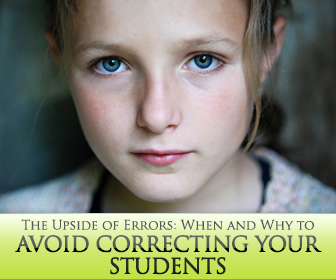Teacherless Troubleshooting: 6 Keys to Students Solving Language Struggles on Their Own


“I mean, I taught math in my home country.” This is a perfect example of when not correcting an ESL student is the best way to handle an error. By signaling her student with a small gesture, the teacher helps the student understands that he made an error. He thinks back to what he said, and then produces the correct structure. This is what in language studies is called self-correction.
Self-correction is just what it sounds like – when students correct their own mistakes rather than depending on the teacher to correct them. Self-correction happens naturally in speech, both with first and second language learners and in spoken and written language. And students who are able to self-correct have many advantages over those who do not.

They are able to recognize mistakes, even in their own speaking and writing, and know what the correct structure should look like. They are then able to produce that correct language on their own even if it is on the second try.
They depend less on their teacher and more on themselves, and they take more responsibility for their own quality of language. When they do this, they can better function in real life language situations and are able to better communicate with native speakers, even when they make mistakes, because they are able to identify and correct those mistakes without help from someone else.
Students must have some level of self-awareness when it comes to their language use if they are going to self-correct. But as students learn to self-correct, they become more aware of their language use and therefore any mistakes they are making. When students are more aware of mistakes, they make fewer. As a result, they become better at self-correcting. Getting students to self-correct, then, begins a positive cycle of awareness and correct language production.

Self-correction can be developed. For students with little experience self-correcting, you can give them sentences with errors that they need to correct. Spending a few minutes on this type of activity each day will increase student awareness of language errors. Creating examples inspired by actual student errors is a good way to make sure your sentence corrections will make a real impact on how your students speak. You can also use examples depicting errors common with speakers of your students’ first language. You may also create examples that highlight grammatical concepts you have recently taught in class. Each of these may serve a different purpose, but all of them will help your students become better self-correctors.
Another way to encourage error awareness and self-correction is to signal your students when they make an error. You can use verbal signals, asking them to repeat themselves for example, or use simple physical clues like raising your eyebrows. If students still struggle with identifying their mistakes, give a more obvious signal like raising you hand when they make an error. The more natural your signals are, and the more subtle they are, the more prepared your students will be for self-correcting on their own.

Making students aware of their mistakes is like walking a thin line – too much and you will end up discouraging your students rather than empowering them. For this reason, remember what level your students are at. Don’t expect perfect speech from beginning level students, and don’t expect them to correct every error they make. For any student, when errors occur in many contexts, try focusing on one or two and let the rest slide (for now). Building a student’s foundation in self-correction is often a slow process and one that should not be rushed. You can always help them tackle more areas of error later, and you want them to feel good about the language they are producing.
Sometimes students will realize their mistakes on their own. Other times the teacher will have to offer a signal that self-correction is needed. She may make a physical signal or say something like, “What was that? Excuse me?” Though establishing a classroom culture where students self-correct may be challenging and time consuming at first, it is well worth it as your students become more effective and more confident English users. They become more independent and are ready to take their English skills out into the real world.
How do you encourage self-correction in your classroom?